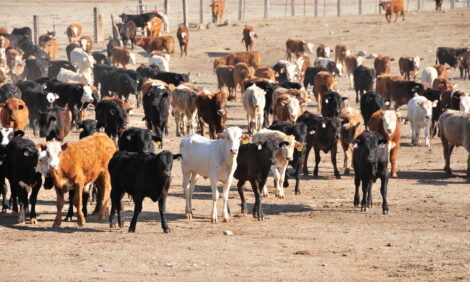



Scottish Cattle Numbers Growing Slowly
SCOTLAND, UK - The latest set of figures on farming in Scotland shows large falls in the number of chickens and in the area growing potatoes over the last year.Scotland's Chief Statistician released the latest results from the June 2015 Agricultural Census.
There were small increases in the number of cattle, sheep and pigs, but a sharp decrease in the number of poultry.
The increase in cattle numbers was of less than one per cent, but was the first increase since 2010. Dairy cattle numbers continued to show growth, up 3,700 (1.4 per cent) to 278,000, though the number of beef cattle also fell by 3,700 (0.5 per cent) to 710,000. There was however a three per cent increase in calf numbers to 544,000 which boosted the total.
New data published this year shows that Limousin are the most common cattle breed in Scotland, followed by Aberdeen Angus, Simmental, Holstein Friesian, and Charolais. These five breeds accounted for 76 per cent of cattle in Scotland.
Sheep numbers increased for the second consecutive year, the first time that has happened since the 1990s, though the increase this year was only 0.1 per cent, to 6.70 million. Although the numbers of both breeding ewes and lambs fell, there was a nine per cent increase in other sheep.
Pig numbers also saw a small increase of 1,500, or 0.5 per cent, to 318,000.
Poultry saw an 11 per cent fall, down 1.7 million to 13.1 million. The reduction was in the broiler sector, which saw a fall of 2.1 million birds (27 per cent) to 5.7 million.
This fall was partially offset by a seven per cent increase in layers, to 6.1 million, and a seven per cent increase in fowls for breeding, to 1.2 million. The number of broilers is now the lowest on current records.
Potatoes were also down, 2,700 hectares (ten per cent) to 26,000 hectares, with reductions in both ware and seed. The area is now the smallest on current records.
The area of cereals decreased by four per cent from 462,000 to 444,000 hectares, with a reduction in the area of barley, down 19,000 hectares to 308,000, and only very small increases in wheat (540 ha) and oats (560 ha). The area of oilseed rape decreased by 1,300 hectares (four per cent) to 36,000 hectares. The area of fallow land almost trebled to 33,000 hectares.
Other figures released show that the area growing strawberries rose by 30 hectares to 940 hectares (a three per cent increase), and raspberries increased by 40 hectares (13 per cent) to 350 hectares.
The amount of agricultural land that was rented for one year or more fell again, by 6,000 hectares or 0.5 per cent, to 1.32 million hectares. This means that 23 per cent of agricultural land is rented compared to 30 per cent in 2003. There were an estimated 6,616 holdings with tenancy arrangements, down 109 or 1.6 per cent since 2014.
There were 65,400 people employed on agricultural holdings, down just under 1,000 on 2014, with new data showing that one fifth of occupiers were female. About 78 per cent of the area of Scotland is agricultural land, in 52,160 agricultural holdings.
TheCattleSite News Desk


